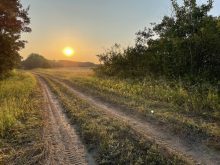Looking for a stable Canadian investment that has a history of outperforming inflation?
Look no further than western Canadian farmland.
That’s the message from Veripath Farmland Partners LP, a Calgary-based farmland partnership that owns about 90,000 acres of productive farmland in Canada’s three prairie provinces, primarily Saskatchewan.
“Farmland has very interesting characteristics but there’s not a very high level of awareness of it, as an investment, outside of the farming community,” said Veripath managing partner Stephen Johnston.
“Farmers are aware of how well farmland has performed over the last 30, 40 or 50 years, but no one else has really been aware of it.”
Read Also

Exports off to a slow start after last year’s torrid pace
Canadian grain, oilseed and pulse exports are off to a slow start, but there are some bright spots, according to the Canadian Grain Commission’s most recent weekly export data report.
Johnston and his management team have been involved in Canadian farmland acquisitions since 2007. During that time, awareness of farmland as an attractive investment opportunity among investors other than farmers has grown.
Institutional and retail investors have come to recognize farmland as stable investment that offers steady returns, low volatility and protection against inflationary pressure, he said.
According to Johnston, the average annualized rate of return on farmland funds managed by Veripath was in the neighbourhood of 11.7 percent per year for the 13-year period ending Dec. 31, 2020.
“That’s without leverage and excluding cash rents,” he said.
“That’s land appreciation only.”
Veripath uses a number of criteria when deciding where to make its farmland purchases.
Key metrics include the price of land per tonne of productive capacity, historical yield trends and yield stability over time.
Land located near urban centres typically does not get through Veripath’s investment screening process because the price is usually influenced by its development potential.
“We buy farmland that’s going to remain as farmland forever,” Johnston said.
“We like the Prairies. It’s 80 percent of Canada’s farmland. And when you look at the last 60 years of data, it’s generated very consistent returns.”
In recent months, interest among institutional investors has grown, he added.
“That’s because farmland has some very unique behaviours during periods of high inflation. Institutional investors are aware of that, so they’ve been very gradually investing in the asset class globally, and now they’re starting to increase those exposures, purely for the inflationary hedge.”
According to some observers, 2022 might be a year when Canadian farmland prices, or at least the rates of farmland appreciation, begin to slow.
Over the past decade, average values across Canada have appreciated by more than 11 percent per year, according to FCC, Canada’s largest farm lender.
On a year-by-year basis, average annual farmland value increases across all Canadian provinces and geographies ranged from a low of 5.2 percent in 2019 to a high of 22.1 percent in 2013, FCC data suggests.
In 2020, average prices rose by a relatively modest 3.6 percent in Manitoba, 5.4 percent in Saskatchewan and six percent in Alberta.
But over the past decade, land prices in Saskatchewan alone have risen by 13.6 percent per year on average, based on FCC’s valuation models.
There are signals that the demand for farmland, at least among farmers themselves, may be slowing.
Across the West, many areas were significantly impacted by drought last year and productivity suffered accordingly.
Farmers coming off a year of disappointing yields may be less inclined to expand land holdings, particularly in an environment of rapidly rising input costs.
The potential for higher interest rates and declining commodity prices could also affect farmers’ land buying decisions, creating a market that’s even more attractive to institutional investors.
In a recent interview with The Western Producer, Ted Cawkwell, a Saskatchewan farmland realtor, said there is potential for a correction in the prairie farmland market.
Farmland values are largely determined by two factors: interest rates and farm income. For the past few years, interest rates have been at historical lows.
Grain prices, meanwhile, reached record levels in late 2021.
“The interest rates don’t have anywhere to go but up and the commodity prices don’t have anywhere to go but down,” said Cawkwell.
J.P. Gervais, chief agricultural economist with Farm Credit Canada, said producer demand for farmland remains reasonably strong on the Prairies, despite lower production in 2021.
“Demand is strong, especially for good dirt, like the high quality land,” he said. “Maybe less so for lower quality land.”
FCC is gathering information for its 2021 farmland values report, but based on preliminary data, average prices for prairie farmland are still rising, albeit at a slower rate than in past years.
In Saskatchewan, for example, average values over the 12-month period ending June 30 had appreciated by approximately 3.5 percent, Gervais said.
“If you look at Q3 — so by the end of September 2021 — I think the 12-month rate of increase will have accelerated a bit, probably in the five to six percent range.”
Although drought conditions in 2021 significantly reduced productivity, 2021 farm receipts for grains, oilseeds and pulse crops could be as much as $1 billion higher than they were in 2020 due to high commodity prices and inventory reductions.
“Really, I think that it’s 2022 that might be a little tricky from an income standpoint,” Gervais said.
However, land that has the capacity for increased productivity will continue to generate interest among farmers.
The same goes for non-producers, said Johnston at Veripath.
In fact, by the end of 2024, Veripath hopes to triple the size of its Canadian farmland portfolio.
“Our 36-month target is 300,000 acres,” he said. “For us, I think the majority of our capital will continue to be invested in Alberta, Saskatchewan and Manitoba.
“Before, (investor) interest was based on the fact that farmland offers very consistent returns and the demand drivers … were very easy to understand.
“Now, we’re getting people who are making allocations into farmland just for the inflation hedge.”


















